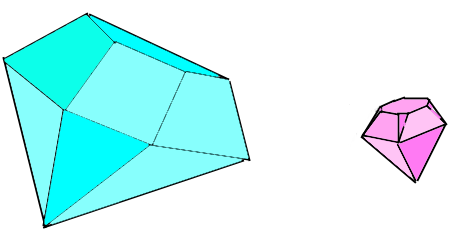Gems for profit
 A jewelry seller is selling two kinds of gems, common blue and rare pink. The seller has €10 000 to buy gems, and each blue stone costs €20 while each pink gem costs €1000. The initial sale prices are €30 for blue and €5000 for pink.
A jewelry seller is selling two kinds of gems, common blue and rare pink. The seller has €10 000 to buy gems, and each blue stone costs €20 while each pink gem costs €1000. The initial sale prices are €30 for blue and €5000 for pink.
As the seller doesn't have many customers wealthy enough to buy rare pink gems, the pink gem's sale price must be reduced by 20% every time one of them is sold. The blue gem's sale price, however, stays at €30. What is the maximum profit the seller can make?
Note: Profit = income minus expenses. Calculator is allowed.
The answer is 14446.4.
This section requires Javascript.
You are seeing this because something didn't load right. We suggest you, (a) try
refreshing the page, (b) enabling javascript if it is disabled on your browser and,
finally, (c)
loading the
non-javascript version of this page
. We're sorry about the hassle.
The blue gem makes €30 income for every €20 spent. That means, €1.5 is earned for every euro spent for blue gems.
This ratio for the pink gem is 5 at the start, as the initial sale price is €5000 and the buying price is €1000. As the price is lowered by 20% for each next gem, the n:th pink gem's price in euros is 5 0 0 0 × 0 . 8 n − 1 . The income per euro spent ratio is 1 0 0 0 5 0 0 0 × 0 . 8 n − 1 = 5 × 0 . 8 n − 1 .
The most profit will be earned when the seller buys pink gems until the next gem he/she would buy, would give less income than €1.5 for each euro spent (the stable income per euro spent ratio for blue gem). We get the following equation:
5 × 0 . 8 n − 1 = 1 . 5
0 . 8 n − 1 = 0 . 3
n − 1 = lo g 0 . 8 0 . 3
n = lo g 0 . 8 0 . 3 + 1
n = 6 . 3 9 5 1 1 . . .
This means, most profit will be made with 6 pink gems bought with €6000, and the other €4000 spent for blue gems:
The income earned with pink gems:
n = 1 ∑ 6 ( 5 0 0 0 × ( 0 . 8 ) n − 1 ) = 0 . 2 5 0 0 0 ( 1 − 0 . 8 6 ) = 1 8 4 4 6 . 4
The income earned with blue gems:
As blue gems make €1.5 income for every euro spent, the income in euros is 4 0 0 0 × 1 . 5 = 6 0 0 0
The total profit is income minus expenses: 1 8 4 4 6 . 4 + 6 0 0 0 − 1 0 0 0 0 = 1 4 4 4 6 . 4 .